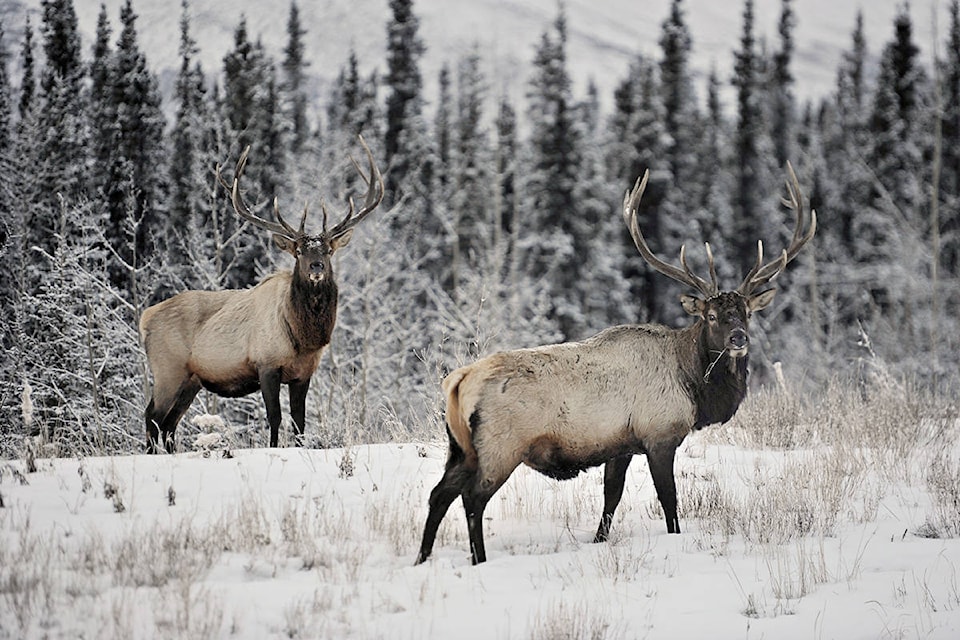Two elk met their end in the frigid waters of the Takhini River last week, say area residents.
Environment Yukon has confirmed they received calls about both animals from concerned observers. Conservation officers were dispatched in both cases, but Environment Yukon can only confirm the death of an elk Nov.13.
They were not present for the death of the second animal, said conservation officer Dave Bakica.
The animals perished in separate instances — one on Nov. 13 and one on Nov. 16 — and were likely attempting to cross the river, said Bakica. Both animals were found at a place along the river the herd had been using as a crossing point earlier in the season, he said. As the river has begun to freeze, ice has gathered in the area, causing water levels to rise, making the animals more likely to be swept up by the current.
Bakica said that this kind of event, although unpleasant to watch, is “natural for wildlife at this time of year.”
Elk will sometimes attempt to use the river as a means of escape from predators, such as wolves, Bakica said, plunging into the water during a chase. This does not appear to be what happened in this case and the animals did not appear to have been fleeing from anything.
In both instances conservation officers decided not to destroy the elk. Conservation officers will sometimes kill an animal that has been badly hurt and cannot be treated for its injuries. Bakica said cases like these are more of a judgment call and conservation officers wanted to give the animals “every opportunity to get out on their own.”
However, not everyone agreed with the decisions made by conservation officers.
Jodi Giesbrecht — whose husband Russ witnessed the Nov. 16 incident and reported it to Environment Yukon — posted on a public Facebook group that “conservation officers refused to dispatch the animal, and instead let it remain struggling for life in full view of River Road traffic while it slowly succumbed to hypothermia and (was) inhaling water.”
Giesbrecht described this as “cruel and outrageous” in her post.
Speaking to the News, Giesbrecht said her husband called conservation officers after he saw the animal struggling in the river around 3:30 p.m. on Nov. 16. When the conservation officer determined a shot for a mercy-kill was possible or necessary, Russ — an experienced guide and hunter, Jodi said — offered to take the shot for him.
“The elk couldn’t get anything but his chin above the water,” Giesbrecht said.
The conservation officer refused, she said, and told her husband that if he attempted to kill the animals himself, he would be breaking the law.
“Having the government prevent us from (ending the elk’s suffering) was very upsetting,” she said. “As a human, when I see an animal suffering and we have the option to stop the suffering, I think we have to stop it.”
Russ confirmed the details provided by his wife, but declined to comment further.
Bakica confirmed that Environment Yukon received requests from people offering to shoot the elk. Both were refused, he said.
“It’s fine and dandy to say ‘shoot it and put it out of its misery,’ but that’s not an easy thing to do.” It is illegal to shoot an animal without the appropriate permit, he said.
The law is in place to protect wildlife, he said, because there are unscrupulous people who will “use any opportunity to take wildlife.”
Giesbrecht said she feels the incident is evidence of problems within the elk herd itself. The elk are an introduced species, and are “still not seeming to fit into the wild” in the Yukon, she said.
Lake Laberge MLA Brad Cathers said several concerned residents in his riding had contacted him about the incidents, including Giesbrecht. He had also heard about the incidents through Facebook, he said.
Based on these conversations, it’s his understanding that “while these things do happen in the wild” the animals died “after a fairly lengthy struggle.”
“The reports I’ve heard are very concerning,” he said.
Cathers recently put the issue of the Takhini and Braeburn elk herds before the legislature, saying that the animals were damaging crops and property. He is asking that more hunting permits be issued for the elk in order to reduce their numbers.
Elk are not native to the Yukon and were introduced as game animals to take pressure off caribou and moose. Currently, the government issues two hunting permits for elk per year via lottery.
Cathers said he will be writing to Environment Minister Pauline Frost about the incident.
Bakica still encourages people to report incidents where wildlife might be in trouble to conservation officers. In the past, conservation officers have been able to save deer who have fallen through the ice by lassoing their antlers and pulling them up out of the water, he said.
“Sometimes there are things that can be done (for wildlife) and sometimes there aren’t,” he said. “Things don’t always work out the way you want them to.”
Contact Lori Fox at lori.fox@yukon-news.com
